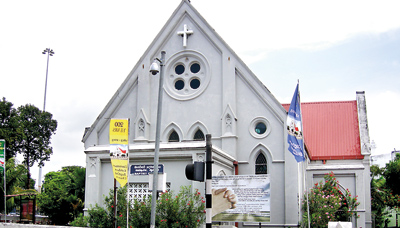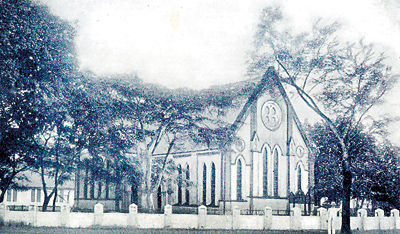The ‘Roundabout’ Church
“Enlarge the place of your tent,
And let them stretch out the curtains of your dwellings;
Do not spare;
Lengthen your cords,
And strengthen your stakes…”
Quoting from the Bible, the Book of Isaiah, Rev. S. J. de S. Weerasinghe writing the 1988 historical record of the Cinnamon Gardens Baptist Church, concluded,

Designed by Rev. F. D. Waldock the church was built by 1877
“The challenge of community outreach, the impulsion of our cultural heritage and the vision of an ecumenical perspective. As I see it, these are the directions in which our immediate future should be deeply involved, with firm resolve and purposeful action.”
The Cinnamon Gardens Baptist Church turns 200 years this month. It stands at the busiest intersection in Colombo, one that has been transformed dramatically over the years. And at the turning of the century, it is a reflection of this metamorphosis, expanding and growing into a truly “local” church.
The ‘elite’ church
Rev. James Chater, Sri Lanka’s first Baptist missionary, arrived on the island with his wife, Anne, and four children, in 1812. His 1813 sermon “in a warehouse somewhere in the Pettah,” marked the beginning of the Baptist Church in Sri Lanka.
Original membership, according the church history, was “made up entirely of Europeans and Burghers”. Many of its early pastors were simply Baptist missionaries with plans to move inland once they had a working knowledge of the people and language of Sri Lanka. So the church rarely had the same pastor for longer than a few years at a time.
Despite this situation the congregation was strengthened in its convictions and grew in number and commitment, starting prayer meetings and Bible studies and even subscribing to build “a proper place of worship”.
It took a quarter of a century for that place to materialise, but in 1875, a plot of land was bought in Cinnamon Gardens for Rs. 4,181. A foundation stone was laid on April 4, 1876 and the church of Rev. F. D. Waldock’s design was built by 1877 at the expense of Rs. 22,126.
A Sinhala church that met separately in the Pettah warehouse in the 1870s was also invited to move its meetings to the Cinnamon Gardens premises. But the English church continued to be a colonial endeavour until 1874, when Mr. P. D. De Silva, the first Sinhala name to appear on the church records, was elected deacon.
In 1874 the congregation also became independent of the Baptist Missionary Society. So in 1875, the then Open Communion Baptist Church became the Cinnamon Gardens Baptist Church, celebrating both the independence and the physical move.
When they first bought the property, the Cinnamon Gardens locality was highly residential, described in the church history as a “leafy solitude”. But the bustle of the Pettah quickly followed the congregation to the intersection at the Lipton circus.
During the Second World War, the church neighbourhood was a hub of activity. The presence of foreign armed forces gave the church plenty of opportunity to “exercise Christian hospitality”. And in return, as the record goes:
“These young forces personnel flooded our church, took the [youth movement] by storm and almost ran it, swelled our choir and occupied our pulpit.”
So much so that once the forces left, the church fell into a “lull”. But this “lull” brought other good news. The 1898 history records an “attempt to unite the Sinhala/Tamil and English congregations,” in order to get away from the elitist label it had gained over the years. Although this attempt didn’t bear immediate fruit, there was gradual change. Half a century later, it was obvious that the membership had become “less exclusive than it was once and … a much truer cross section of the educated population of Ceylon”.
Becoming the ‘Roundabout’ Church
The metamorphosis boomed in the late 1950s. Rev. Sutton Smith revived evangelism with open-air programmes and creative presentations of the gospel even in rural areas and prisons. He also strengthened inclusiveness by turning the separate Sinhala/Tamil and English churches into one church with two congregations in 1961. In 1963, he concluded the 150th anniversary history with strong words:
“The fact is that we are faced today with a daunting task, and we are not sufficient for it … May God make us a people of prayer, a dedicated people, willing to be used, people strong enough in the Spirit to take the opportunity that lies outside our Church doors.”
Nihal Perera, one of the oldest and most senior members of the current congregation remembers Sutton Smith’s time, and sees the transformation the church has gone through, since:
“This church is primarily for the Sinhala and Tamil speaking roundabout community … In my youth, all the members came from far away. Now, the members and leaders in the Tamil/Sinhala congregation originally came from the nearby tenements.”
A significant event in this transformation took place in the 1980s when the Sunday school doors were opened to all children in the neighbourhood.
“It was supposed to be the bourgeois Colombo 7 area,” Perera says, “and we were also tagged as a Colombo 7 church. But from that time we tried hard to break through that and say we are for the people in the area.”
As Perera remembers it, the church “tried to be indigenous. We introduced Sinhala singing and songwriting, used the magul bere and the thabla, and had our plays in Sinhala and Tamil. When all these people were calling us a Colombo 7 church, we were having avurudu celebrations!”
The ‘purpose-driven’ church
On February 20, 1988, the Cinnamon Gardens Baptist Church took another solid step towards becoming a truly local body. Rev. Kingsley Perera was ordained and became the first national pastor of the church.
Rev. Perera was Assistant Commissioner at the Department of Probation and Child Care Services until 1987 and his interest in social work continued to influence his pastoral work. Through his initiative, in 1992 the church opened the Dev Piya Sevana, where they housed many of their already well-established outreach programmes including a cafeteria and counselling services. This further helped the church to reach out, as Sutton-Smith envisioned, outside its doors.
But the most recent and tangible change came about in the lead-up to the Easter of 2007. Under the guidance of current pastor Rev. Gary Dean, the church body took on the ‘Forty Days of Purpose’ study by Rick Warren. “I don’t know how folks knew about it,” Rev. Dean muses. But the impact was tangible. “It was a powerful time.”
Nearly 80 per cent of the congregation was involved in a study group during the period. This led to greater involvement of the membership in all areas of church activity, and a radical restructuring of its organisation and constitution.
Rev. Kingsley Perera, now in his retirement, looks at the current congregation and is encouraged.
“There has been tremendous growth in the church, both physically and spiritually,” he says. And as far as one may see and hear, the congregation at the Colombo 7 roundabout has grown as Rev. Weerasinghe envisioned, steadily, over two centuries, into a truly purpose driven church.
A time for thanksgiving

The Cinnamon Gardens Baptist Church began its anniversary celebrations with “How Great Thou Art,” an evening of truly extravagant worship on September 1. The congregation was led by Mariazelle Goonetilleke, Rukshan Perera, The Priests, Choro Benedicte, VoicePrint and Devashrie de Silva among other well-known Christian artists.
September 19 saw 150 students from more than ten Baptist Sunday schools from Colombo and the suburbs participate in a Bible Olympics. Secretary of the Church, Devika Ukwatte said the organisers were “not ready” for the success of the event, where 14 students achieved full scores for memory verses.
The celebrations will peak over the weekend of October 18-20 at the church premises:
- Friday, October 18, 6 p.m.– Gospel Rally
- Saturday, October 19, 6 p.m. – ‘Yesterday, Today, Tomorrow,’ a pageant with music, dance, mime and multi-media, showcasing the past, present and future of the church.
- Sunday, October 20, 10 a.m. – 200th Anniversary Thanksgiving Service


